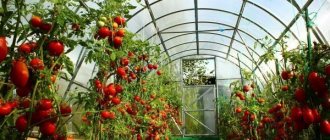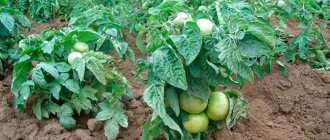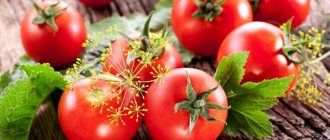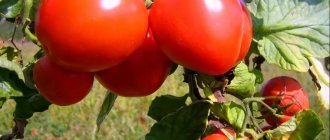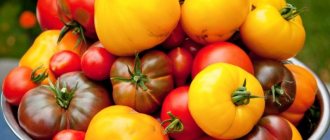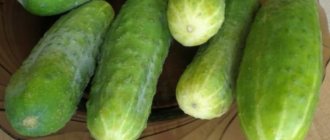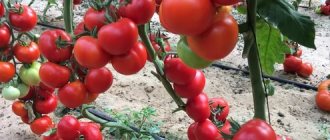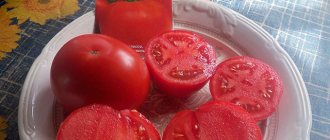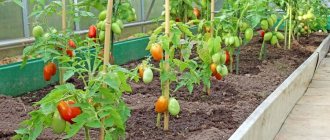Growing tomatoes in the Moscow region is a rather difficult task. Summers in the region are often cool and humid with many stormy days. Tilling the soil and preparing it for placing seedlings requires considerable effort: dense, clayey soils predominate in the Moscow region. Every spring, melt water stagnates in garden plots. The soil warms up slowly, and many people fail to plant seedlings in the beds for a long time.
In this article we talk about what you need to pay attention to when choosing tomato seeds for planting in the Moscow region or regions similar in climatic conditions
However, summer residents do not lose heart and with enviable tenacity they are trying to grow a full-fledged crop of tomatoes in their gardens. Our article is addressed to those who did not give up and did not give up on their dreams. Today we will advise readers how to choose the best varieties of tomatoes for the Moscow region.
The State Register of Breeding Achievements contains information about many hybrids and varieties of tomatoes. When searching for productive tomato varieties for the Moscow region, it is advisable to also be guided by them.
The best varieties of tomatoes for the Moscow region for a greenhouse
Many summer residents prefer to grow tomatoes in a greenhouse because it is very convenient and allows them to achieve a great harvest. The best varieties are considered to be: De Barao, Blagovest, Nevsky, Bull's Heart, Pink Honey, Sweet Bunch, Andromeda F1.
De barao
High-yielding variety for universal use. Suitable not only for the Moscow region, but also for other regions. The harvest ripens in August, and fruiting lasts until frost. The fruits are oval-shaped and come in different colors: pink, yellow, red or black. Their average weight is 90 grams. Productivity – 4 kilograms per bush.
Blagovest
Early ripening high-yielding hybrid. The first fruits can weigh 100 grams, and later their weight decreases to 60 grams. The harvest tolerates transportation well and is suitable for fresh consumption or harvesting.
Nevsky
An ancient variety that is very popular. The bushes are low, up to 50 centimeters. The average fruit weight is 60 grams, and up to 7.5 kilograms of harvest can be obtained from a bush. The purpose of the variety is universal.
Bull's heart
Large-fruited option, known to every summer resident. The tomatoes are heart-shaped, weighing from 300 grams to 1 kilogram. They are very juicy and tasty; you can eat them fresh, add them to salads and juices. There are varieties of yellow and black shades.
Pink honey
The fruits are heart-shaped and can weigh up to 600 grams. The pulp is quite juicy and aromatic. It is best to eat them fresh, make juice or sauce from them. The harvest is poorly stored: it is prone to cracking.
Sweet bunch
One of the earliest ripening varieties, the growing season of which is about 90 days. One bush produces about fifty tomatoes weighing up to 40 grams. They are best suited for canning and juicing.
Andromeda F1
An early ripening hybrid that takes only 3 months to ripen. You can get about 10 kilograms of harvest from a bush, the average weight of each fruit is 120 grams. It is very important to pick the plants correctly.
Climate Features
The Moscow region is located in a temperate climate zone, which is characterized by distinct seasons. Summers here are warm and winters are moderately cold. Cyclones often come here from different directions of the world, and the winds are predominantly westerly.
Features of the climate of the Moscow region in numbers:
- average winter temperature – minus 10°С;
- average summer temperature – plus 17°C;
- maximum winter temperature – minus 39°C;
- average annual precipitation is 550-650 mm;
- winter duration – 151 days;
- snow cover height – up to 40cm.
On a note! Snow in the Moscow region falls at the end of November, and melts completely by the beginning of April.
The terrain in the region is mostly flat, which is conducive to the construction of greenhouses. Hilly terrain is typical for the western part of the Moscow region, lowland – for the eastern part.
The soils are predominantly loamy, in the lowlands - soddy-podzolic, marshy, sandy loam, sandy. Chernozems are rare, but those that exist are too podzolized and leached.
For open ground
You can also grow tomatoes in open ground. To get a good harvest, you need to choose the right variety. One of the following is best: White filling, Sultan, Tamara, Vzryv, Otradny, Anyuta, Shchelkovsky, Winter cherry, Alenka.
White filling
A variety that has been known for several decades. At the stage of technical maturity, the fruits have a whitish tint. The fruits weigh from 80 to 130 grams and ripen together. They have a pleasant aroma, you can add them to salads, make juices, and can them.
Sultan
Hybrid version, bred in Holland. Ideal option for the Moscow region. Well adapted to different weather conditions. It takes 70 days for the crop to fully ripen. The maximum weight of one vegetable is 200 grams. Tomatoes are used for fresh consumption, making juices and pastes.
Tamara
A low-growing variety with large fruits weighing up to 300 grams (sometimes more). The productivity of the variety is high. The vegetable pulp is juicy and tasty. They can be used fresh or processed in any way.
Explosion
A high-yielding variety characterized by resistance to crown and root rot. The approximate weight of one fruit is 100 grams. When growing in open ground, it is best to organize a film shelter. The crop is used for salads or processing, but not for preservation.
Otradny
Low-growing variety with early ripening. The approximate weight of one vegetable is 70 grams. The tomatoes have a pleasant taste and are not prone to cracking. They can be eaten fresh or canned.
Anyuta
A hybrid that bears fruit 3 months after the first shoots. The purpose of the fruit is universal: they are suitable for pickling and pickling for the winter. You can get up to three kilograms of vegetables from a bush.
Shchelkovsky
Super early variety, harvest is obtained after 90 days. Maturation is friendly. Tomatoes have a pleasant taste and aroma. Unfortunately, they cannot be stored for a long time.
Winter cherry
Vegetables can reach a weight of 30-40 grams. The ripe fruit is red and round. You can get up to 4 kilograms of harvest from a bush.
Alenka
A hybrid beloved by many, which produces a harvest 90 days after germination. Up to 14 kilograms of vegetables are obtained per square meter.
Hybrids
Compared to varietal tomatoes, hybrids have more advanced characteristics. They are more productive, hardier, and more disease resistant. They have one drawback - they do not produce seeds that retain the qualities of the parent plant. Therefore, hybrid seeds cannot be prepared on your own; you have to buy them. Below is a rating of hybrid tomatoes for greenhouses.
Beefseller gold
Indeterminate early hybrid. The height of the bushes is up to 2 m. The fruits are orange, ribbed, and contain a lot of beta-carotene. From 1 sq. m harvest up to 18-20 kg of tomatoes. The growing season is 100 days. Weight – 300-350 g. This variety is grown mainly in greenhouses. The disadvantages of a hybrid are that it is difficult to transport and requires careful care.
Verlioka F1
Hybrid up to 1.5 m high. Productivity – 16-18 kg. Tomatoes are small, round, smooth, with dense pulp. Color – deep red, weight – up to 120 g. Good harvest. One bush produces up to 4.5 kg of fruits, which are tasty fresh or canned. The hybrid is resistant to many diseases. The growing season is 105 days.
Leopold F1
Ultra-early determinate hybrid, ripening in 90 days. The height of the bushes is 1-1.2 m. The fruits are the same size, round, red, 90-100 g each. They taste sweet, with a pronounced tomato aroma. The fruits ripen quickly and are well transported. Practically does not suffer from tomato mosaic, cladosporiosis, or late blight. Productivity – up to 4.2 kg per 1 sq. m.
On a note! Determinate tomatoes are those whose growth is limited to a certain height after the clusters set with fruit. Indeterminate grow up to 4 m in height.
Diva F1
Ultra-early tall hybrid. The bushes grow up to 1.3 m. The growing season is 90-95 days. The fruits are medium-sized, red, round, with a “spout”. Average weight – 180 g. Taste is good, marketability is high. Characterized by high adaptive abilities. Resistant to late blight. From 1 sq. m harvest 6-8 kg.
Blagovest F1
Determinate early hybrid with rather tall and branched bushes - up to 1.8 m. The fruits are round and red. The skin is strong, does not crack, and the fruits retain their presentation for a long time. Weight 100-200 g. Ripening time - 100-105 days. The hybrid is resistant to tobacco mosaic and late blight. It is characterized by increased resistance to pests - the Colorado potato beetle and mole cricket. Small fruits are suitable for canning. Productivity – 5-6 kg per bush, per 1 sq. m harvest up to 17 kg.
Tornado F1
A mid-early, low-growing hybrid with fleshy red fruits. The shape is round. The taste is excellent. Fruit weight – 80-120 g. Bush height – 0.5 m. Ripening time – 105-110 days. Resistant to fungal infections and weather changes. Productivity – up to 20 kg per 1 sq. m.
Alenka F1
A relatively new ultra-early hybrid with powerful bushes and medium-sized fruits. Plant height is 0.4-0.6 m. The fruits are juicy and sweetish. From 1 sq. m harvest up to 15 kg of tomatoes. They can withstand the vagaries of the weather. The fruits do not crack, are well stored and transported. Application – universal.
Sultan F1
Hybrid of Dutch origin. The bushes are compact, up to 0.6 m high. They do not require staking. The fruits are flat-round, weighing 100-120 g. Ripening time is 90-100 days. The fruits are tasty, bright red, sugary, they make delicious juices, purees, they are added to lecho and other preparations. Resistant to heat, tolerates moisture deficiency well. Transportability is high.
The most productive tomato varieties for the Moscow region
Of course, any summer resident wants to get a good harvest of tomatoes. To do this, it is worth considering the following varieties: De Barao, Nevsky, Sweet Bunch, Anromeda F1, Fitous, Akademik Sakharov, Alyosha Popovich, Babushkina Radost, Alisa, Bulgarian Challah.
De Barao
The description of this variety is presented above.
Nevsky
This variety has been described previously.
Sweet bunch
This variety is described above.
Andromeda F1
The characteristics of this hybrid were presented earlier.
Fitous
A mid-season variety characterized by a number of advantages, including resistance to many diseases. The weight of a tomato is about 70 grams. Up to 12 kilograms of harvest are obtained per square meter.
Academician Sakharov
Mid-season species, producing up to 6 kilograms of yield per bush. You will have to take care of a reliable garter, since the stem is quite tall. The vegetables are round and weigh up to 350 grams.
Alesha Popovich
A variety beloved by many summer residents. Tomatoes are flat and round, weighing up to 260 grams. There can be up to 6 tomatoes on one brush.
Grandmother's joy
The tall bush needs staking, but as a reward for good care it will delight the owner with a wonderful harvest with juicy pulp. Individual vegetables can weigh about a kilogram. The estimated yield is up to 6 kilograms per bush.
Alice
American variety, mid-early. The weight of one tomato is up to 450 grams. It is resistant to many diseases. You can get up to 6 kilograms of harvest from a bush. Of course, for this you need to take good care of it.
Bulgarian challah
Mid-season variety, producing large pink tomatoes. Their average weight is 750 grams. Productivity – 6 kilograms per bush.
Factors for selecting varieties
It is not easy to select the best varieties of tomatoes for greenhouses among the variety of assortments in 2022. Every gardener has his own understanding of “the best”; every plot of land has a special microclimate. Should be considered:
Purpose of cultivation: for family needs or for sale
For sale on the market, options with standard, leveled fruits, transportable, and with the highest possible return are selected. For personal needs, everything is determined by one’s own preferences.
Purpose and variety of fruits
We love tomatoes for their incredible variability: in terms of ripening time, shape, color, taste, nutritional value, and culinary capabilities.
Before the start of the planting season, you need to decide on your expectations: how many early vegetables do you want, and how many will go for storage, are you planning to preserve whole fruits, etc. You need to think in advance about the ratio of salad and pickling varieties, red and multi-colored, early and mature, the number of cherry and etc. "Targeting" in favor of one group can later lead to disappointment.
Need for stability or exoticism
There are gardeners with an ineradicable craving for experimentation, for whom yield and reliability indicators are not the most important.
Design features of the greenhouse
Many parameters matter.
- The assortment of tomatoes for year-round and summer greenhouses will differ. Plants for winter greenhouses (equipped with special heating) are expected to have increased stress resistance and tolerance to a lack of sunlight.
- The temperature regime of the greenhouse plays a huge role. The possibility of timely through ventilation, length, volume of air, number and location of doors and vents, automatic thermoregulation, greenhouse materials (film, polycarbonate, glass, agrofibre) - all this influences the choice of tomato variety.
In an optimal, stable microclimate, any options will be successful.
But breeders also offer specially bred forms that can withstand extreme heat, temperature contrasts, and cold snaps.
Water supply
Tomato plants love constant moderate humidity in the root zone. If it is not possible to ensure this, it is necessary to plant varieties that are not prone to fruit cracking and are drought-tolerant.
Disease forecast
This factor is one of the most important in greenhouse tomato cultivation. Indoor soil accumulates many harmful pathogens, which are very difficult to resist.
Special hybrid varieties cope with this problem more successfully.
But some vegetable growers are fundamentally opposed to hybrids due to fear of GMOs, while others do not like the “rubbery” density and bland taste of the fruits, and the cost of hybrid seeds is high, and there is a risk of running into a fake.
When giving preference to non-hybrid forms, it is necessary to carefully consider agricultural technology : the possibility of crop rotation, disinfection of seeds and greenhouses, ventilation, regular chemical or biological treatments, etc.
Bush height and potential yield
Not everything is decided by agricultural technology; each variety has its own “ceiling”. Of course, the most productive varieties of tomatoes for greenhouses are the most early ripening, but with long-lasting returns. As a rule, these are tall tomatoes - indeterminate. They must be reared into 1-2 (less often 3) trunks.
Is it possible to plant determinate tomatoes in a greenhouse? In general, the answer is yes, but the specific choice depends on the situation:
- Tomatoes with a determinate type of growth are convenient, but not too short - the so-called “semi-determinant”. They themselves slow down in development at a height of 120-150 cm, having tied several tiers of brushes. To further continue their growth (if necessary), leave the upper stepson - it will replace the stopped tip.
- Low-growing determinants are sometimes used as a border seal in greenhouse beds.
- Early ripening determinate tomatoes are a forced choice for greenhouses heavily infected with fungal and bacterial infections (when a significant part of the crop is lost annually). An early and healthy harvest will have time to ripen before the massive development of infections. After harvesting the fruits, the greenhouse is occupied with other vegetables (greens, radishes) or green manure.
Scheme: How to choose tomato seeds for greenhouses and open ground
Is it possible to grow different varieties of tomatoes in one greenhouse?
The answer is simple: it is possible, and even necessary. Tomatoes are a self-pollinating crop, and the harvest will begin even if there is only one variety, this is quite acceptable. But this will not satisfy all needs; Moreover, diversity reduces the role of instability and the risk of failure. It is advisable to plant both proven varieties and new selections annually.
New varieties of tomatoes
New products are the most resistant to diseases. Selection is also carried out to increase productivity, uniformity of fruits, and improve taste.
- Alexander the Great F1
- Accordion
- High society F1
- Wrist strike F1
- Baba
- Clear Falcon F1
Early
Early varieties of tomatoes allow you to get a harvest in the shortest possible time. The following varieties deserve special attention: Moskvich, Alenka, Sultan, Blagovest, Andromeda F1, White filling, Esfigmen, Amber placer, Almeida, Amacco.
Moskvich
A unique variety of culture. Bushes up to 40 centimeters high can be planted quite close to each other. The vegetables are small, up to 50 grams, round and pleasant to the taste. The plant is characterized by resistance to late blight and temperature changes.
Alenka
A description of this variety is presented above.
Sultan
This variety has been described previously.
Blagovest
The characteristics of the variety are presented above.
Andromeda F1
This variety of tomatoes was described earlier.
White filling
The description of the variety can be found above.
Esphigmen
The most large-fruited and productive option. Vegetables reach a weight of 300 grams, round, scarlet in color. You can get up to 30 kilograms of tomatoes per square meter, and their marketability is close to 100%.
Amber placer
A yellow-fruited variety that produces vegetables weighing up to 110 grams. About 15 kilograms of fruit are harvested per square meter. Marketability is about 100%.
Almeida
This variety is best suited for pickling. Tomatoes reach a weight of 120 grams, scarlet. 26 kilograms of crop are harvested per square meter. Marketability – 98%.
Amako
Another variety that performs well in pickling. The maximum fruit weight is 195 grams. 23 kilograms of vegetables are harvested per square meter.
Which tomatoes are best to plant?
Before choosing the best variety, you need to decide how the cultivation will take place (open or closed ground) and what the fruits will be used for.
Important! It is necessary to purchase zoned seeds.
Low-growing, early-ripening hybrid varieties are suitable for open beds and collapsible greenhouses. They will have time to ripen before they are affected by late blight.
When growing in permanent greenhouses, the ripening period is not given any importance. You need to focus on the height of the plant and the taste characteristics of the fruit. Indeterminate ones are suitable for such cultivation, allowing you to get a large harvest from a minimum area. When selecting varieties, it is important to focus on cultivation rules. It is recommended to grow plants that are resistant to late blight and other fungal diseases.
The most delicious and sweet varieties of tomatoes for the Moscow region
Tomatoes themselves are very sweet, but there are some that stand out among their peers. The following can be particularly highlighted: Medok, Alenka, Pink Honey, Bull's Heart, Bombay F1, Raspberry Dawn, Pudovik.
Nectar
An early-ripening variety, tomatoes grow in clusters of up to 6 pieces. The average weight of a vegetable is 100 grams. You can transport crops over long distances.
Alenka
The description of this variety is presented above.
Pink honey
The characteristics of this variety can be found above.
Bull's heart
The Bull's Heart was described earlier.
Bombay F1
A good hybrid, fruit weight – up to 300 grams. Not afraid of most common diseases.
Crimson Dawn
Tall variant with medium ripening time. Raspberry-colored tomatoes, heart-shaped. Reach a weight of 400 grams.
Pudovik
A meaty version bred by Siberian specialists. The weight of one vegetable is about 300 grams, but there are specimens up to a kilogram.
Which varieties are classified as early
First of all, you need to decide which varieties of tomatoes belong to early and ultra-early.
REFERENCE. Ripening time is the most important characteristic by which tomatoes are classified.
Early-ripening tomatoes are usually called those that begin to bear fruit 90-95 (plus or minus 10) days after the first shoots appear.
Ultra-early - those that produce tomatoes already 2.5 months after seedling germination.
It is important to understand this: 80, 90, 95 days are approximate dates. Much depends on the summer resident himself, as well as weather conditions and what kind of care is provided. With regular feeding in a good year, even early tomatoes can be harvested after 85 days.
And, conversely, if the tomatoes do not have enough light during cultivation, the year is dry or rainy, and the summer resident provides poor care for the plantings, then the tomatoes may ripen longer than the specified period.
The most important factors are, of course, warmth and sunlight.
IMPORTANT! The ripening time is indicated on the back of the packet of seeds.
short
Low-growing varieties do not produce stepsons, which makes caring for them much easier. The following options deserve the most attention: Leningradsky Chill, Barnaul Cannery, Alsou, Snowdrop, Mirage.
Leningrad chill
From each bush you can get up to 20 vegetables of pleasant taste. The tomato skin is red and shiny, the flesh is quite dense.
Barnaul Cannery
Ideal for growing in open ground. Fruits are elongated. The purpose of the variety is universal, since the pulp is quite dense and tasty.
Alsou
A popular variety that produces large fruits up to 500 grams. The pulp is juicy and tender, very sweet. Vegetables can be used not only fresh, but also for preparing juices, pastes and sauces.
Snowdrop
An early ripening option that is not afraid of cold weather. The average weight of one fruit is 150 grams. The culture is unpretentious in care, but requires hilling.
Mirage
A variety for universal use. The fruits can be eaten fresh or processed in any convenient way. The harvest survives transportation well.
Answers to frequently asked questions
Is it possible to grow very early varieties of tomatoes in the garden?
Yes, there are varieties for open ground. But do not rush to plant seedlings, wait for favorable weather conditions.
Are there early varieties of large and fleshy tomatoes?
There are quite a lot of them. Moreover, both those that have long been known to summer residents, and those that are relatively new.
Indeterminate varieties of tomatoes
Such tomatoes can be grown either in open ground or under film. In the greenhouse you will have to carefully monitor their growth. The following varieties are considered the best: Yalik, Axel, Pink Beauty, Neuron, Yugra.
Skiff
Ideal for salads. The approximate weight of the fetus is 120 grams. It is quite possible to get up to 20 kilograms of crop per square meter with a yield of almost 100%.
Axel
A variety of medium ripeness, good in salads or pickling. The weight of one vegetable is about 200 grams. Marketability – 99%. It is worth noting that culture needs to be shaped. Productivity – 11 kilograms per square meter.
Pink Beauty
Vegetables of this variety are good for salads or pickles. Tomatoes weigh on average 172 grams. Productivity – 12 kilograms per square meter.
Neuron
Mid-season variety, best suited for salads or pickling. The weight of the fetus is 110 grams or more. You can get about 26 kilograms of harvest per square meter.
Ugra
This variety is good in salads. Feels good under shelters and in the open air. The weight of one tomato is 160 grams. Productivity – 25 kilograms per square meter.
Varieties for the Urals and northwestern regions
Summer is short in the Urals. Therefore, it is also not easy to grow tomatoes in this region. The main thing is to choose varieties that were created specifically for the conditions of the Urals. When grown in a greenhouse they give a good harvest.
Biathlon F1
High-yielding. Red tomatoes weigh about 90 g.
Alaska
They give a good harvest in any climatic conditions. Salad purpose. Red tomatoes weigh about 80 g.
Boni MM
Early ripening. You can enjoy the first fruits already in early July. Almost never gets sick. Red tomatoes weigh about 90 g.
Large-fruited
Large-fruited tomatoes are usually grown in greenhouses. In some varieties, the fruits weigh more than a kilogram. The following varieties have proven themselves best: Bull's Heart, Mazarin, Cardinal, Bear's Paw, Altai Yellow.
Bull's heart
This variety has been described previously.
Mazarin
Early ripening tall variant. Vegetables can reach a weight of 750 grams. The culture is characterized by resistance to most diseases and temperature changes.
Cardinal
Mid-early self-pollinating variety. Productivity is high - up to 17.5 kilograms per square meter. Some tomato specimens reach a weight of one kilogram.
Bear Paw
A culture resistant to adverse conditions. Produces vegetables weighing up to 800 grams. The taste is pleasant, but not for everyone, as there are sour notes.
Altai yellow
Ripening occurs 110 days after emergence. The fruits are yellow, average weight is 600 grams. The pulp is incredibly tasty. Productivity – 13 kilograms per square meter.
Peach
Orange tomatoes weigh about 90 g. For salad purposes.
In this article, we presented the most popular and best low-growing varieties for greenhouses, which can be grown in the conditions of Siberia, the Urals and the Moscow region, the middle zone, the north-west and south of Russia. It is worth noting that most varieties on this list require regular watering and sufficient sun. They also need to be fed and grown in fertile soil. As these conditions change, the yield will also change.
Watch the video! Is it worth planting low-growing tomatoes in a greenhouse?
Advantages
- The tomatoes are very tasty, meaty, sugary.
- Thanks to the presence of early and late varieties, tomatoes are harvested throughout the summer. There are also varieties that bear fruit until the coldest weather.
- Large fruits are in great consumer demand, so they are often grown for sale.
- Most often, these tomatoes are used for preparing for the winter, making juices and pastes.
- These varieties are distinguished by good yield.
- The plant is grown in the plots with maximum use of space.
The advantages of large tomatoes also include their wide range of colors and varied fruit shapes. They can be red, yellow, brown, pink, white and even multi-colored. The shape of these tomatoes is round, elongated, ribbed, flat and pepper-shaped.
With a large number of advantages, large-fruited tomato varieties have some features, which are sometimes called their disadvantages:
- The fruits are not used for whole canning due to their large size. Tomatoes cannot be cut into pieces, as they have very delicate flesh.
- The skin of the fruit is thin. When transporting over long distances and long-term storage, special conditions are required.
- With insufficient watering, the yield of the variety decreases and the fruits are smaller. Oversaturation of moisture affects the quality of tomatoes. At the same time, they begin to crack.
- The variety can produce high yields and large-sized tomatoes only on nutritious and fertile soil.
More information about growing tomatoes is described in the article: Technology of growing tomatoes. Secrets of planting and care
You might be interested in: How to properly plant tomatoes in a greenhouse: bush formation diagram, care features, photos and videos
Useful information: How to properly tie tomatoes in open ground: the best methods, step-by-step photo and video instructions
There are a large number of varieties of large sweet tomatoes. Below we offer a description of the best of them.

